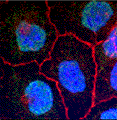Biochemistry, Department of
Document Type
Article
Date of this Version
2010
Citation
THE JOURNAL OF BIOLOGICAL CHEMISTRY VOL. 286, NO. 14, p. 12812, April 8, 2011 (Correction)
THE JOURNAL OF BIOLOGICAL CHEMISTRY VOL. 285, NO. 39, pp. 29911–29924, September 24, 2010 (Original article)
Abstract
The aim of this study is to identify the exact mechanism(s) by which cytoskeletal structures are modulated during bone resorption. In this study, we have shown the possible role of different actin-binding and signaling proteins in the regulation of sealing ring formation. Our analyses have demonstrated a significant increase in cortactin and a corresponding decrease in L-plastin protein levels in osteoclasts subjected to bone resorption for 18 h in the presence of RANKL, M-CSF, and native bone particles. Time-dependent changes in the localization of L-plastin (in actin aggregates) and cortactin (in the sealing ring) suggest that these proteins may be involved in the initial and maturation phases of sealing ring formation, respectively. siRNA to cortactin inhibits this maturation process but not the formation of actin aggregates. Osteoclasts treated as above but with TNF-α demonstrated very similar effects as observed with RANKL. Osteoclasts treated with a neutralizing antibody to TNF-α displayed podosome-like structures in the entire subsurface and at the periphery of osteoclast. It is possible that TNF-α and RANKL-mediated signaling may play a role in the early phase of sealing ring configuration (i.e. either in the disassembly of podosomes or formation of actin aggregates). Furthermore, osteoclasts treated with alendronate or αv reduced the formation of the sealing ring but not actin aggregates. The present study demonstrates a novel mechanistic link between L-plastin and cortactin in sealing ring formation. These results suggest that actin aggregates formed by L-plastin independent of integrin signaling function as a core in assembling signaling molecules (integrin αvβ3, Src, cortactin, etc.) involved in the maturation process.
Included in
Biochemistry Commons, Biotechnology Commons, Other Biochemistry, Biophysics, and Structural Biology Commons



Comments
© 2010 by The American Society for Biochemistry and Molecular Biology, Inc. Used by permission.
[Nandakumar Madayiputhiya was omitted from the original list of authors.]